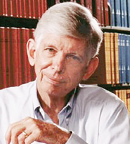Considered a visionary in cancer research, Alfred George Knudson, MD, PhD, was internationally recognized for his “two-hit theory” of cancer causation, which explained the relationship between hereditary and nonhereditary cancer types, predicting the existence of tumor suppressor genes. Dr. Knudson died on July 10, 2016. He was 94.

Alfred George Knudson, MD, PhD
Dr. Knudson was born in Los Angeles on August 9, 1922. After high school, he entered the California Institute of Technology in 1940. He originally planned on a career in physics, but after 2 years, he switched his major to biology, working in the laboratory of Thomas Hunt Morgan, who won the Nobel Prize in Physiology or Medicine in 1933 for discoveries elucidating the role the chromosome plays in heredity.
During his time at Caltech, World War II broke out, and Dr. Knudson joined the Navy. An officer explained that they didn’t need PhDs in genetics; the war effort needed doctors and engineers, and he advised Dr. Knudson to stay in school. He entered Columbia University, receiving his MD in 1947.
A Formative Time
During an interview, Dr. Knudson said his initial interest in cancer did not come during medical school. “At that time, we had almost no instructions in cancer. You could either remove the tumor surgically or let people die. During my first year of residency at Cornell New York Hospital, I spent 1 month across the street at Memorial, which had a 20-bed pediatric cancer unit and no full-time pediatrician. I spent a month dealing with children with cancer, and it made a very deep impression. That was when I decided to work in the cancer field,” said Dr. Knudson.
In 1953, James Watson and Francis Crick published their famous paper on the discovery of DNA, which rocked the world, especially the world of the aspiring young geneticist. Dr. Knudson returned to Caltech to earn his PhD. While he was there, James Watson arrived to do work on RNA. It was a formative time in Dr. Knudson’s career.
Seminal ‘Two-Hit Hypothesis’
Dr. Knudson came to Fox Chase from The University of Texas Graduate School of Biomedical Sciences, where he was Dean, and the MD Anderson Hospital and Tumor Institute in Houston, where he specialized in pediatrics and biology. Previously, he was Associate Dean for Basic Sciences at the State University of New York at Stony Brook from 1966 to 1969.
He began his affiliation with Fox Chase in 1970 as a member of its scientific advisory committee, and it was there in 1971 that he did his seminal work leading to the Knudson Hypothesis, otherwise known as the “two-hit hypothesis.” This now-confirmed theory advanced the understanding of errors in the genetic program that turn normal cells into cancer cells and guided later investigations by tumor geneticists and molecular biologists.
The fact that the statistical models he created to explain both the hereditary and sporadic forms of retinoblastoma, neuroblastoma, and Wilms tumor were first proposed 15 years before molecular technologies were available speaks to the novelty of his work. Dr. Knudson also mapped the retinoblastoma susceptibility gene to chromosome band 13q14, a work that laid the foundation for the eventual cloning of the first tumor suppressor, RB1.
Tribute by Colleague
At the news of his passing, colleagues and friends paid tribute to a towering figure in cancer research who also was known as a gentle and thoughtful man. His long-time colleague at Fox Chase Alfonso
Bellacosa, MD, PhD, spoke with The ASCO Post, stressing that above all, Dr. Knudson was a charming and caring person.
“Before Dr. Knudson got down to business, he would always first ask, ‘So, how are you? How’s the family doing?’ And it wasn’t a formality; it was because he truly cared about you. He was a terrific mentor and despite his scientific accomplishments, he was always eager to talk to anyone, never showing the weight of his gravitas. And he also balanced his life in the laboratory with his passionate interests in art, music, and traveling,” revealed Dr. Bellacosa.
Dr. Knudson spent most of his career at Fox Chase Cancer Center, where he held several management positions, including that of President. Dr. Knudson and his wife, Anna T. Meadows, MD, a pediatric oncologist at Children’s Hospital of Philadelphia, collaborated on the study of the genetics of childhood cancer. ■

